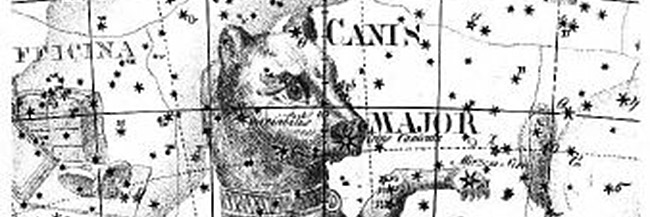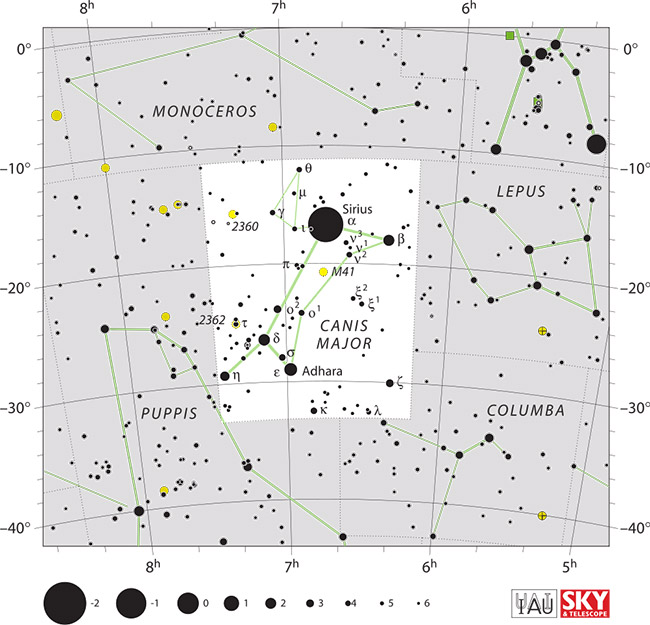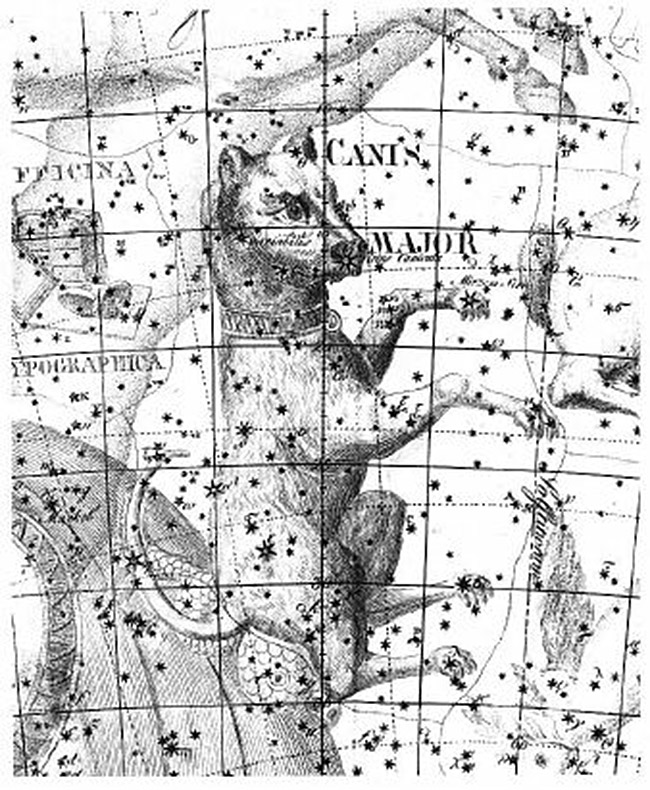Canis Major – Constellation Facts
 Alessio Govi, CC BY-SA 3.0, via Wikimedia Commons
Alessio Govi, CC BY-SA 3.0, via Wikimedia Commons
Canis Major is derived from the Latin language and means “the greater dog,” representing the bigger dog following Orion. It can be found in the second quadrant of Southern hemisphere and is located specifically between latitudes of +60° and -90°. This constellation was also catalogued by the Greek astronomer, Ptolemy, in the 2nd century.
Constellation Characteristics
The relatively simple shape of Canis Major is the 43rd largest constellation in the night sky, occupying 380 square degrees. Canis Major is also neighbors with Columba, Lepus, Monoceros and Puppis. In addition, this constellation has eight stars, five Messiers and other deep space objects.

IAU and Sky & Telescope magazine (Roger Sinnott & Rick Fienberg), CC BY 3.0, via Wikimedia Commons
By IAU and Sky & Telescope magazine (Roger Sinnott & Rick Fienberg) CC BY 3.0, via Wikimedia CommonsPlanetary Systems
Canis Major has five deep sky objects. Read on to discover some fascinating facts about these celestial wonders.
- Messier 41 (M41, NGC 2287): this open cluster is estimated to be between 190 and 240 million years old. It is located 4 degrees South of Sirius and contains about 100 stars. The brightest star in this cluster is a K3-type giant, while the rest are mostly red giants.
- Canis Major Dwarf Galaxy: first discovered in 2003, this irregular galaxy contains around a billion stars with a huge number of red giants. It is situated about 25,000 light-years from Earth.
- NGC 2359 (Thor’s Helmet): centered around a hot giant on the verge of exploding, this emission nebula is located 15,000 light-years from us.
- NGC 2207 and IC 2163: these colliding spiral galaxies are estimated to be around 80 million light-years away. The bigger galaxy is pulling stars out of the smaller one.
Main Stars
The constellation Canis Major contains eight main stars that makes up its shape. Let’s explore them further.
- Sirius (Alpha Canis Majoris) shines the brightest in the Canis Major constellation (which will be discussed later in detail).
- Adhara (Epsilon Canis Majoris) is the second brightest star in this constellation and also the 24th brightest in the night sky. This binary star gets its name from the Arabic language meaning “virgins.”
- Wezen (Delta Canis Majoris) is a F-type supergiant that shines the third brightest in Canis Major. It is around 10 million years-old and will eventually turn into a red supergiant then go supernova.
- Murzim (Beta Canis Majoris) has a surface that pulsates, therefore it varies in brightness. It is classified as a blue-white giant.
- Aludra (Eta Canis Majoris) is approaching the end of its life and is expected to go supernova in the next few million years.
- Tau Canis Majoris is located 3,200 light-years from Earth and is catalogued as an eclipsing spectroscopic binary star.
- Phurud (Zeta Canis Majoris) is a spectroscopic binary star that consists of a blue-white B-type main sequence dwarf and a star that is unseen.
- Muliphein (Gamma Canis Majoris) is located 402 light-years away and is blue-white B-type right giant.

Alessio Govi, CC BY-SA 3.0, via Wikimedia Commons
Canis Major on Chart XVIII of Johann Bode’s Uranographia (1801)Most Shining Star
Out of all the stars that make up the Canis Major constellation, none shine brighter than Sirius. This well known star shines the brightest in the night sky and is fifth nearest to the sun. Sirius is also called “the Dog Star” and is classified as a binary star. Sirius A is twice the mass of the sun and is 25 times more luminous, while Sirius B is one of the most massive white dwarfs known today and is equal in mass to the Sun.
Mythology & History
Canis Major is symbolized as a dog standing on its hind legs in pursuit of a rabbit. This constellation has also been described as “the dog with the blazing face” because Sirius (the brightest star) appears to be in the dog’s jaws.
Canis Major also has a legend associated with it. It was thought that Zeus gave, Laelaps (the fastest dog in the world) to Europa as a gift, along with a javelin. However, the gift had a tragic ending as Europa was killed accidentally when her husband (Cephalus) was hunting with the javelin. As the story goes, Cephalus took the gifted dog to Thebes in Boeotia to hunt a nuisance fox, which also had outstanding running abilities. Once in pursuit, the dog chased the fox until Zeus turned them both into stone. He then placed the dog in the sky as Canis Major.
Canis Major is a fascinating constellation, so the next time you are gazing into the night sky, be sure to search out this intriguing figuration of stars.
